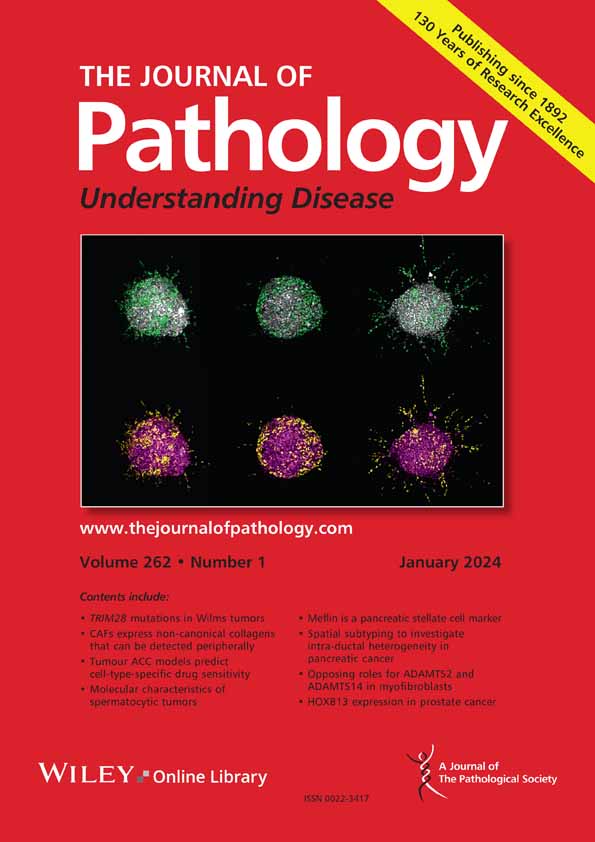Shinsuke Akita, Sanae Ikehara, Masahiro Kiuchi, Kota Kokubo, Kazuhiko Azuma, Syouta Ohki, Hiroyuki Matsuyama, Joceline Theda Kadarman, Yohei Hosokawa, Yoshihiro Akimoto, Yosuke Inaba, Hideki Hanaoka, Nobuyuki Mitsukawa, Kiyoshi Hirahara, Toshinori Nakayama, Yuzuru Ikehara
下载PDF
{"title":"瘢痕疙瘩淋巴管和血管内成纤维细胞和内皮细胞中PIEZO2机械受体的表达增加。","authors":"Shinsuke Akita, Sanae Ikehara, Masahiro Kiuchi, Kota Kokubo, Kazuhiko Azuma, Syouta Ohki, Hiroyuki Matsuyama, Joceline Theda Kadarman, Yohei Hosokawa, Yoshihiro Akimoto, Yosuke Inaba, Hideki Hanaoka, Nobuyuki Mitsukawa, Kiyoshi Hirahara, Toshinori Nakayama, Yuzuru Ikehara","doi":"10.1002/path.6455","DOIUrl":null,"url":null,"abstract":"<p>Keloids are scars that grow abnormally due to excessive extracellular matrix production by fibroblasts and increased angiogenesis. Chronic tension is implicated in their growth, but the exact pathology remains unclear. This study investigated the increased expression of molecules responsible for sensing pressure in keloids compared with lymphedema, which is also a non-tumorous fibroproliferative disease caused by another etiology. Higher expression levels of <i>COL1A2</i>, <i>PIEZO2</i>, and <i>POSTN</i> were observed in the keloid group compared with the lymphedema group. <i>PIEZO2</i> expression levels showed a strong correlation with both <i>COL1A2</i> (<i>r</i> = 0.9252, 95% CI 0.8474–0.9641, <i>p</i> < 0.001) and <i>POSTN</i> (<i>r</i> = 0.9118, 95% CI 0.8213–0.9575, <i>p <</i> 0.001). Additionally, <i>PIEZO2</i> expression levels were significantly higher in recurrent keloids than in non-recurrent keloids (3,032.5 ± 1,090.2 versus 1,241.9 ± 860.7, <i>p</i> = 0.032). Analysis of gene expression at the single-cell level found upregulation of <i>PIEZO2</i> in vascular and lymphatic endothelial cells, and a subgroup of fibroblasts. Additionally, <i>COL1A1</i>, <i>COL1A2</i>, <i>COL3A1</i>, and <i>POSTN</i> expression was also increased in the fibroblast subgroup. Furthermore, in fibroblasts with high <i>PIEZO2</i> expression, extracellular matrix collagen production signaling was augmented. Histological analysis confirmed the presence of PIEZO2-positive cells in the perivascular stroma active area of keloid tissue, together with inflammatory cells. Therefore, since PIEZO2-positive cells are highly expressed specifically in keloids and are deeply involved in their recurrence and activity, we propose that the pathogenesis of keloids is constructed by PIEZO2-positive cells. © 2025 The Author(s). <i>The Journal of Pathology</i> published by John Wiley & Sons Ltd on behalf of The Pathological Society of Great Britain and Ireland.</p>","PeriodicalId":232,"journal":{"name":"The Journal of Pathology","volume":"267 1","pages":"105-119"},"PeriodicalIF":5.2000,"publicationDate":"2025-07-31","publicationTypes":"Journal Article","fieldsOfStudy":null,"isOpenAccess":false,"openAccessPdf":"https://pathsocjournals.onlinelibrary.wiley.com/doi/epdf/10.1002/path.6455","citationCount":"0","resultStr":"{\"title\":\"Increased expression of the PIEZO2 mechanoreceptor in fibroblasts and endothelial cells within the lymphatic and vascular vessels of keloids\",\"authors\":\"Shinsuke Akita, Sanae Ikehara, Masahiro Kiuchi, Kota Kokubo, Kazuhiko Azuma, Syouta Ohki, Hiroyuki Matsuyama, Joceline Theda Kadarman, Yohei Hosokawa, Yoshihiro Akimoto, Yosuke Inaba, Hideki Hanaoka, Nobuyuki Mitsukawa, Kiyoshi Hirahara, Toshinori Nakayama, Yuzuru Ikehara\",\"doi\":\"10.1002/path.6455\",\"DOIUrl\":null,\"url\":null,\"abstract\":\"<p>Keloids are scars that grow abnormally due to excessive extracellular matrix production by fibroblasts and increased angiogenesis. Chronic tension is implicated in their growth, but the exact pathology remains unclear. This study investigated the increased expression of molecules responsible for sensing pressure in keloids compared with lymphedema, which is also a non-tumorous fibroproliferative disease caused by another etiology. Higher expression levels of <i>COL1A2</i>, <i>PIEZO2</i>, and <i>POSTN</i> were observed in the keloid group compared with the lymphedema group. <i>PIEZO2</i> expression levels showed a strong correlation with both <i>COL1A2</i> (<i>r</i> = 0.9252, 95% CI 0.8474–0.9641, <i>p</i> < 0.001) and <i>POSTN</i> (<i>r</i> = 0.9118, 95% CI 0.8213–0.9575, <i>p <</i> 0.001). Additionally, <i>PIEZO2</i> expression levels were significantly higher in recurrent keloids than in non-recurrent keloids (3,032.5 ± 1,090.2 versus 1,241.9 ± 860.7, <i>p</i> = 0.032). Analysis of gene expression at the single-cell level found upregulation of <i>PIEZO2</i> in vascular and lymphatic endothelial cells, and a subgroup of fibroblasts. Additionally, <i>COL1A1</i>, <i>COL1A2</i>, <i>COL3A1</i>, and <i>POSTN</i> expression was also increased in the fibroblast subgroup. Furthermore, in fibroblasts with high <i>PIEZO2</i> expression, extracellular matrix collagen production signaling was augmented. Histological analysis confirmed the presence of PIEZO2-positive cells in the perivascular stroma active area of keloid tissue, together with inflammatory cells. Therefore, since PIEZO2-positive cells are highly expressed specifically in keloids and are deeply involved in their recurrence and activity, we propose that the pathogenesis of keloids is constructed by PIEZO2-positive cells. © 2025 The Author(s). <i>The Journal of Pathology</i> published by John Wiley & Sons Ltd on behalf of The Pathological Society of Great Britain and Ireland.</p>\",\"PeriodicalId\":232,\"journal\":{\"name\":\"The Journal of Pathology\",\"volume\":\"267 1\",\"pages\":\"105-119\"},\"PeriodicalIF\":5.2000,\"publicationDate\":\"2025-07-31\",\"publicationTypes\":\"Journal Article\",\"fieldsOfStudy\":null,\"isOpenAccess\":false,\"openAccessPdf\":\"https://pathsocjournals.onlinelibrary.wiley.com/doi/epdf/10.1002/path.6455\",\"citationCount\":\"0\",\"resultStr\":null,\"platform\":\"Semanticscholar\",\"paperid\":null,\"PeriodicalName\":\"The Journal of Pathology\",\"FirstCategoryId\":\"3\",\"ListUrlMain\":\"https://pathsocjournals.onlinelibrary.wiley.com/doi/10.1002/path.6455\",\"RegionNum\":2,\"RegionCategory\":\"医学\",\"ArticlePicture\":[],\"TitleCN\":null,\"AbstractTextCN\":null,\"PMCID\":null,\"EPubDate\":\"\",\"PubModel\":\"\",\"JCR\":\"Q1\",\"JCRName\":\"ONCOLOGY\",\"Score\":null,\"Total\":0}","platform":"Semanticscholar","paperid":null,"PeriodicalName":"The Journal of Pathology","FirstCategoryId":"3","ListUrlMain":"https://pathsocjournals.onlinelibrary.wiley.com/doi/10.1002/path.6455","RegionNum":2,"RegionCategory":"医学","ArticlePicture":[],"TitleCN":null,"AbstractTextCN":null,"PMCID":null,"EPubDate":"","PubModel":"","JCR":"Q1","JCRName":"ONCOLOGY","Score":null,"Total":0}
引用次数: 0
引用
批量引用






 求助内容:
求助内容: 应助结果提醒方式:
应助结果提醒方式:


